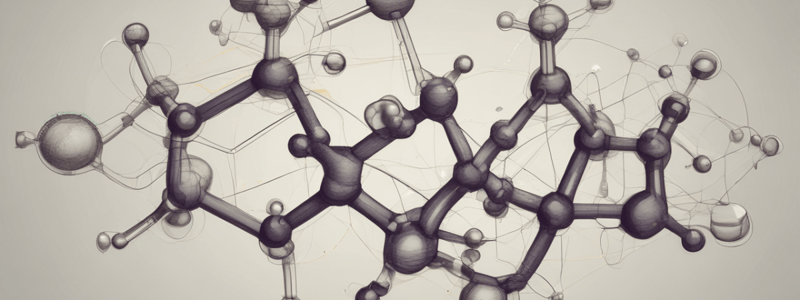Podcast
Questions and Answers
What is the general formula for alkanes?
What is the general formula for alkanes?
- CnH2n+1
- CnHn
- CnH2n+2 (correct)
- CnH2n-2
What is the simplest alkane?
What is the simplest alkane?
- Ethane
- Propane
- Butane
- Methane (correct)
What is the main source of alkanes?
What is the main source of alkanes?
- Natural gas and petroleum (correct)
- Natural gas and wood
- Petroleum and coal
- Natural gas and coal
What is the difference between each member of the alkane series?
What is the difference between each member of the alkane series?
What does IUPAC stand for?
What does IUPAC stand for?
What type of hydrocarbons are alkanes classified as?
What type of hydrocarbons are alkanes classified as?
What is the characteristic of saturated compounds?
What is the characteristic of saturated compounds?
What is the percentage of methane in natural gas?
What is the percentage of methane in natural gas?
What is the general molecular formula for cycloalkanes?
What is the general molecular formula for cycloalkanes?
What is the simplest cycloalkane?
What is the simplest cycloalkane?
How are cycloalkanes named?
How are cycloalkanes named?
What is the use of cyclopropane in the field of medicine?
What is the use of cyclopropane in the field of medicine?
What happens to the number of hydrogens in a cycloalkane when a ring is formed?
What happens to the number of hydrogens in a cycloalkane when a ring is formed?
What is the use of cycloalkanes in the pharmaceutical industry?
What is the use of cycloalkanes in the pharmaceutical industry?
What is the class suffix for alkanes?
What is the class suffix for alkanes?
How should the parent chain be numbered in alkane nomenclature?
How should the parent chain be numbered in alkane nomenclature?
What is the main reason why alkanes are soluble in non-polar compounds?
What is the main reason why alkanes are soluble in non-polar compounds?
What is the trend of the melting point of alkanes with increase in molecular weight?
What is the trend of the melting point of alkanes with increase in molecular weight?
Why are alkanes called paraffins?
Why are alkanes called paraffins?
What is the main use of some alkanes in dentistry?
What is the main use of some alkanes in dentistry?
When choosing the parent chain, what should be done if there are more than one different chain of equal length?
When choosing the parent chain, what should be done if there are more than one different chain of equal length?
What is the force that attracts alkane molecules?
What is the force that attracts alkane molecules?
Flashcards are hidden until you start studying
Study Notes
Organic Chemistry
- Organic chemistry is the study of the structure, properties, composition, reactions, and preparation of carbon-containing compounds.
- Most organic compounds contain carbon and hydrogen, but may also include other elements such as nitrogen, oxygen, halogens, phosphorus, silicon, and sulfur.
Aliphatic Hydrocarbons
- Aliphatic hydrocarbons are compounds drawn in an open-chain format.
- They can be classified into two types: saturated and unsaturated compounds.
Saturated Compounds
- Saturated compounds are those in which two carbon atoms are linked together only via a single bond.
- Alkanes are a type of saturated compound.
Alkanes
- Alkanes are organic compounds that consist of single-bonded carbon and hydrogen atoms and lack any other functional groups.
- All alkanes have the formula CnH2n+2.
- The simplest alkane is methane.
- Alkanes with unbranched carbon chains are called normal alkanes.
- Each member of the series differs from the next higher and the next lower member by -CH2 group (methylene group).
- Sources of alkanes are natural gas and petroleum.
Nomenclature of Alkanes
- Alkanes are named according to the following rules:
- Class suffix is ane.
- Choose the longest chain of carbon atoms and name it.
- Number the parent chain, starting at the end closer to the substituent.
- Identify the substituent and its positions.
- Attach the number and name of the substituent to the name of the parent in alphabetical order.
Physical Properties of Alkanes
- Alkanes are non-polar compounds.
- The attractive forces between molecules are weak.
- The first four members are gases at room temperature, while the C5 to C17 alkanes are liquids.
- Soluble in non-polar compounds and insoluble in water.
- Alkanes are colorless and odorless by nature.
- The intermolecular Vander Waal force attracts alkane molecules.
- Alkanes with stronger intermolecular van der Waals forces have higher boiling points.
- The melting point of alkanes follows the same trend as their boiling point, increasing with increase in molecular weight.
Importance of Alkanes in Dentistry
- Anesthetics: Some alkanes, like halothane, have been used as inhalation anesthetics in dental procedures.
- Solvents: Alkanes serve as solvents for various dental materials.
- Impression Materials: Hydrocarbon-based impression materials are widely used in dentistry.
- Waxes: Dental waxes, used for modeling and casting, often contain alkanes.
- Lubricants: Alkanes find applications as lubricants for dental instruments and equipment.
Cycloalkanes
- Cycloalkanes are alkanes in which the carbon atoms are arranged in a ring.
- General molecular formula: CnH2n.
- The simplest cycloalkane is cyclopropane.
- Nomenclature of cycloalkanes:
- Cycloalkanes are named according to the number of carbon atoms in the ring with the prefix cyclo-added.
- If C ring = or > C substituent, it is named as an alkyl-substituted cycloalkane.
- If C ring < C substituent, it is named as a cycloalkyl-substituted alkane.
Uses of Cycloalkanes
- In the pharmaceutical industry, they are employed as organic solvents.
- Cancer patients are treated with carboplatin, a drug synthesized from cyclobutane.
- Used as perfumes in the perfume industry and as pigments.
- Cyclopropane is employed as an anesthetic agent in the field of medicine.
- It is also utilized in petroleum industries.
Studying That Suits You
Use AI to generate personalized quizzes and flashcards to suit your learning preferences.




